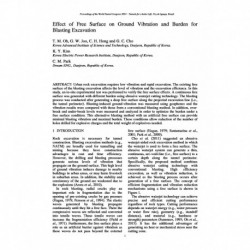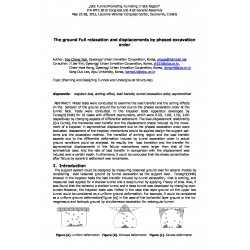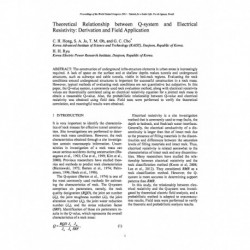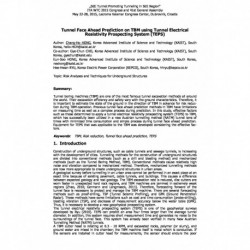No document
Search & filter
Search for a publication
Search & filter
List of products by author: C. H. Hong
-
Effect of Free Surface on Ground Vibration and Burden for Blasting Excavation
Abstract: Urban rock excavation requires low vibration and rapid excavation. The existing free surface of the blasting excavation affects the level of vibration and the excavation efficiency. In this study, an in-situ experimental test was performed to verify the free surface effects. A continuous free surface was generated with different burden using abrasive waterjet cutting technology. The blasting...
0,00 € -
The ground Full relaxation and displacements by phased excavation order
Abstract: Model tests were conducted to examine the load transfer and the aching effects on the behavior of the ground around the tunnel due to the phased excavation order at the tunnel face. Tests were conducted in the trapdoor tests apparatus developed by Terzaghi(1946) for 16 cases with different overburdens, which were 0.5D, 1.0D, 1.5D, 2.0D respectively by changing aspects of differential...
0,00 € -
Theoretical Relationship between Q-system and Electrical Resistivity: Derivation and Field Application
Abstract: The construction of underground infra-structure elements in urban areas is increasinglyrequired. A lack of space on the surface and at shallow depths makes tunnels and underground structures, such as subways and cable tunnels, viable in bed-rock regions. Evaluating the rock conditions around underground structures is important for successful construction in a rock mass. However, typical methods...
0,00 € -
Tunnel Face Ahead Prediction on TBM using Tunnel Electrical Resistivity Prospecting System (TEPS)
Abstract: Construction of underground structures, such as cable tunnels and sewage tunnels, is increasing with the development of cities. Tunnelling methods for the construction of underground structures are divided into conventional methods (such as a drill and blasting method) and mechanized methods (such as the Tunnel Boring Method, TBM). Conventional methods cause relatively high noise and vibration...
0,00 €




